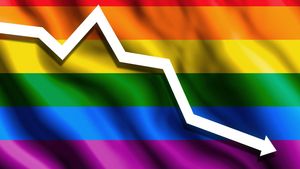A new study reveals especially high rates of eating disorders among transgender college students. Published in the August issue of The Journal of Adolescent Health (the official journal of the Society for Adolescent Health and Medicine), the results show that the prevalence of eating disorders in transgender students is far highter then those of their cisgender (that is, non-trans) classmates.
The study, concucted by researchers at Washington University at St. Louis, accessed data on 289,024 students representing 223 U.S. universities. The students participated in the American College Health Association-National College Health Assessment, a national survey of a broad range of health behaviors, outcomes and perceptions among college students.
To identify eating disorders, students were asked if they have been diagnosed or treated by a professional for anorexia or bulimia in the past year. Responses from transgender students indicated that they had been diagnosed with eating disorders in the past year at what researchers called "an alarming rate" of 15.82 percent, regardless of their sexual orientation. Cisgender students reported much lower rates of eating disorders overall.
The rates for cisgender students ranged from a low of .55 percent (for heterosexual men) to 3.66 percent (men who were "unsure" of their sexual orientation), and 4.29 percent for heterosexual women. But both cisgender men and women who identified as "sexual minority" (sexual minority includes gay, lesbian and bisexual) or "unsure" in the survey were found to be two to four times more likely to have a diagnosed eating disorder than cisgender heterosexual students.
An earlier study, “Eating Disorder Symptoms and Obesity at the Intersections of Gender, Ethnicity, and Sexual Orientation in US High School Students,” found that men who identified as gay, bisexual, and unsure of their sexual orientation were all significantly more likely than heterosexual men to have an eating disorder diagnosis and to “engage in compensatory behaviors.”
The study also measured reported use of diet pills or laxitives or vomiting. The results reflected similarly high rates. For example, transgender students reported much higher rates (13.5 percent) of using diet pills in the past month than compared to cisgender heterosexual men (1.88 percent) and heterosexual women (4.29 percent).
“Transgender individuals may use disordered eating behaviors to suppress or accentuate particular gendered features," suggested lead author Dr. Alexis E. Duncan, in explanation of the findings. "It has been suggested that striving for weight loss may be a way for transgender women to conform to feminine ideals of slimness and attractiveness.”
Another reason, the researchers point to is stress, a common trigger of eating disorders. There is research to suggest the stress levels of transgender individuals is elevated due to being the victims of stigma and discrimination.
Referencing several studies, the authors note, "Among lesbian, gay, and bisexual individuals, a strong link has been found between higher levels of minority stress and poorer mental health outcomes. The same mechanisms are likely at play in transgender individuals, who may be exposed to substantial amounts of discrimination, both on an interpersonal and societal level."
Because the survey only asked about eating disorders that had been treated or diagnosised within the past year, there remains the likelihood that other students have eating disorders but remain undiagnosised or for which they are not currently receiving treatmenet.
The study also does not consider whether more transgender-identified students are diagnosised with eating disorders because they are more likely to be receiving regular health care. Transgender individuals pursuing medical transitions, frequently must undergo psychological counseling and usually receive regular hormone treatments.
Read the article abstract here.













































































